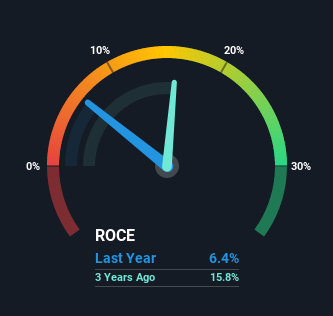Investors Could Be Concerned With Visteon's (NASDAQ:VC) Returns On Capital
What financial metrics can indicate to us that a company is maturing or even in decline? More often than not, we'll see a declining return on capital employed (ROCE) and a declining amount of capital employed. Trends like this ultimately mean the business is reducing its investments and also earning less on what it has invested. So after we looked into Visteon (NASDAQ:VC), the trends above didn't look too great.
Understanding Return On Capital Employed (ROCE)
For those who don't know, ROCE is a measure of a company's yearly pre-tax profit (its return), relative to the capital employed in the business. To calculate this metric for Visteon, this is the formula:
Return on Capital Employed = Earnings Before Interest and Tax (EBIT) ÷ (Total Assets - Current Liabilities)
0.064 = US$90m ÷ (US$2.2b - US$775m) (Based on the trailing twelve months to March 2021).
Therefore, Visteon has an ROCE of 6.4%. In absolute terms, that's a low return and it also under-performs the Auto Components industry average of 11%.
See our latest analysis for Visteon
In the above chart we have measured Visteon's prior ROCE against its prior performance, but the future is arguably more important. If you'd like to see what analysts are forecasting going forward, you should check out our free report for Visteon.
What Can We Tell From Visteon's ROCE Trend?
There is reason to be cautious about Visteon, given the returns are trending downwards. To be more specific, the ROCE was 14% five years ago, but since then it has dropped noticeably. Meanwhile, capital employed in the business has stayed roughly the flat over the period. Companies that exhibit these attributes tend to not be shrinking, but they can be mature and facing pressure on their margins from competition. So because these trends aren't typically conducive to creating a multi-bagger, we wouldn't hold our breath on Visteon becoming one if things continue as they have.
The Bottom Line
In summary, it's unfortunate that Visteon is generating lower returns from the same amount of capital. However the stock has delivered a 70% return to shareholders over the last five years, so investors might be expecting the trends to turn around. In any case, the current underlying trends don't bode well for long term performance so unless they reverse, we'd start looking elsewhere.
Like most companies, Visteon does come with some risks, and we've found 1 warning sign that you should be aware of.
While Visteon may not currently earn the highest returns, we've compiled a list of companies that currently earn more than 25% return on equity. Check out this free list here.
This article by Simply Wall St is general in nature. It does not constitute a recommendation to buy or sell any stock, and does not take account of your objectives, or your financial situation. We aim to bring you long-term focused analysis driven by fundamental data. Note that our analysis may not factor in the latest price-sensitive company announcements or qualitative material. Simply Wall St has no position in any stocks mentioned.
Have feedback on this article? Concerned about the content? Get in touch with us directly. Alternatively, email editorial-team (at) simplywallst.com.

